The Consumer Electronics Show (CES), held every January in Las Vegas, is the platform PC makers use to tease new features that will hit laptops in the year to follow. Display technology has served as a headliner at several recent shows, and Asus is doing its part to again give displays the limelight at CES 2024, delivering a one-two punch in the form of improved Mini-LED and OLED displays.
Make no mistake: these rank among the best displays available on a gaming laptop, ever.
Looking for more options? Check out PCWorld’s roundup of the best gaming laptops.
Asus’ new Mini-LED is a retina-scorching treat
Asus’ first salvo is the 2024 ROG Strix Scar 18. It packs a Mini-LED panel with 2,304 dimming zones. That’s a huge upgrade over the 2023 Asus ROG Flow X16, which had an already impressive 1,024 dimming zones, and it places the ROG Strix Scar closer to Apple’s MacBook Pro 16, which has 2,554 dimming zones. Asus will also bring Mini-LED to the 16-inch ROG Strix Scar, which will have 2,048 dimming zones.
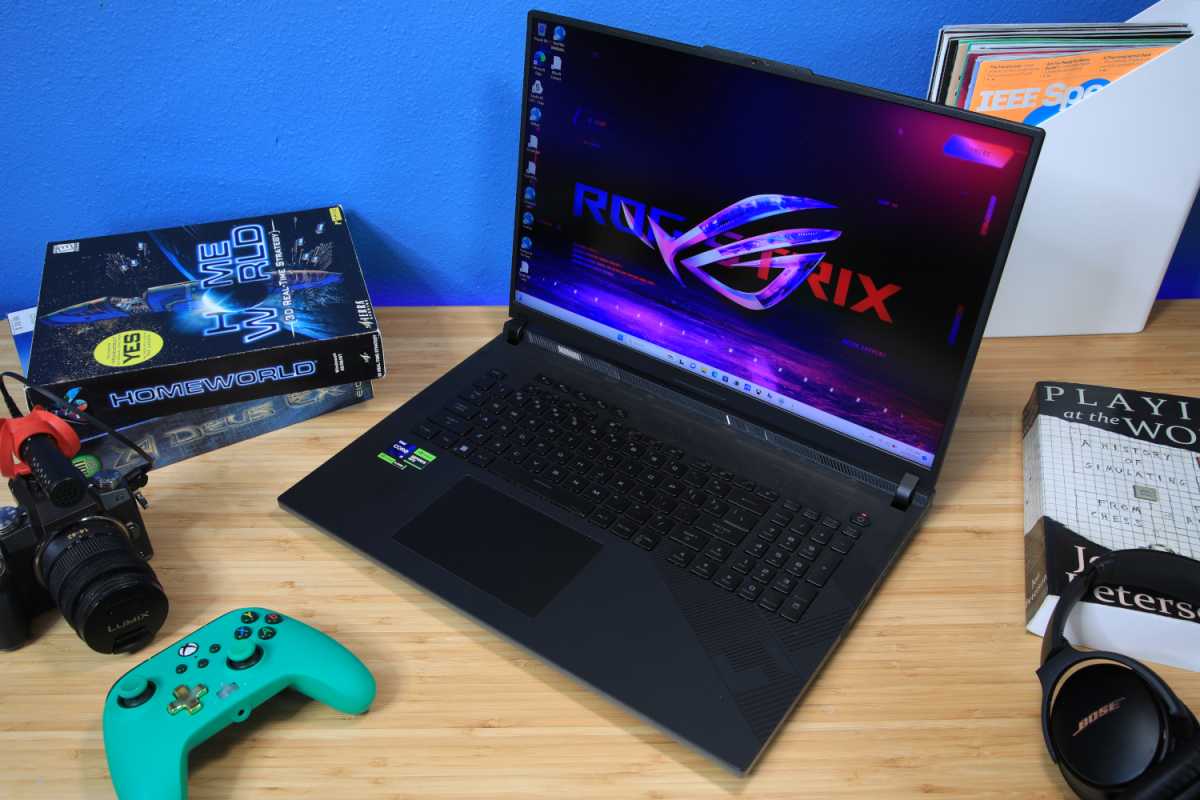
IDG / Matthew Smith
Upping the zones is critical. Older backlit LCD displays use just a handful of LED lights, usually arranged around the edge of the display. Mini-LED replaces that with a grid of LEDs placed directly behind the LCD panel. Each “zone” is a section of the display that can adjust its brightness independently of those around it. Increasing the number of zones improves detail and nuance in high-contrast scenes.
The upgrade is obvious even in casual use. The flash of an explosion in a game or action moving can appear brilliant and dazzling while the darkness around it remains deep and inky. Small, bright objects still display “blooming” — a bright halo around the object — which occurs because the dimming zones aren’t as small as the object on screen. But stuffing 2,304 zones into an 18-inch screen means the problem is subtle in real-world use.
Tests proved the point. The ROG Strix Scar 18’s Mini-LED display reached an effectively infinite contrast ratio in most situations, as dark areas of the screen were completely, totally dark. But that did change at maximum brightness: this reduced the contrast ratio to 25600:1. That’s not as good as OLED, but it hugely outperforms a typical IPS-LCD display, which struggles to hit a contrast ratio of 1500:1.

IDG / Matthew Smith

IDG / Matthew Smith

IDG / Matthew Smith
Brightness clearly skews in Mini-LED’s favor. Asus’ panel achieved a gobsmacking maximum brightness of 1,153 nits. Bright HDR scenes look appropriately brilliant, and the added brightness helps to preserve luminance detail in an HDR image. I’ve reviewed a few Mini-LED laptops that achieve a similar level of brightness, like the Lenovo Slim Pro 9i and Apple MacBook Pro 16, but most don’t. Even Mini-LED monitors often end up slightly dimmer.
The ROG Strix Scar 18’s Mini-LED aced my color gamut and accuracy tests, too. It displayed 100 percent sRGB, 100 percent DCI-P3, and 91 percent of AdobeRGB, all while maintaining a high level of color accuracy. Asus’ OLED displays still beat Mini-LED in color gamut, but not by much, and the Mini-LED’s performance is excellent. Sharpness is good, too, thanks to the display’s 2560×1600 resolution.
And there’s one specific, yet important, arena where the Mini-LED display easily thumps any OLED laptop I’ve tried: SDR with HDR turned on. Most monitors and laptops have trouble handling SDR content when HDR is turned on in Windows, which can lead to a reduced color gamut and reduced color accuracy. But the ROG Strix Scar 18 didn’t show this problem at all. On the contrary, it was slightly better with HDR on than off. That’s an unusual advantage, and one you’ll appreciate if you want to view HDR content in a window on the Windows 11 desktop.
The first OLED laptop with G-Sync is revealed
The Mini-LED display is impressive, but Asus is hedging its bets with the new Asus ROG Zephyrus G14 and G16. The G14 has a 2880×1800 display with a refresh rate of 120Hz while the G16 has a 2560×1600 display with a maximum refresh rate of 240Hz and both include Nvidia G-Sync support.
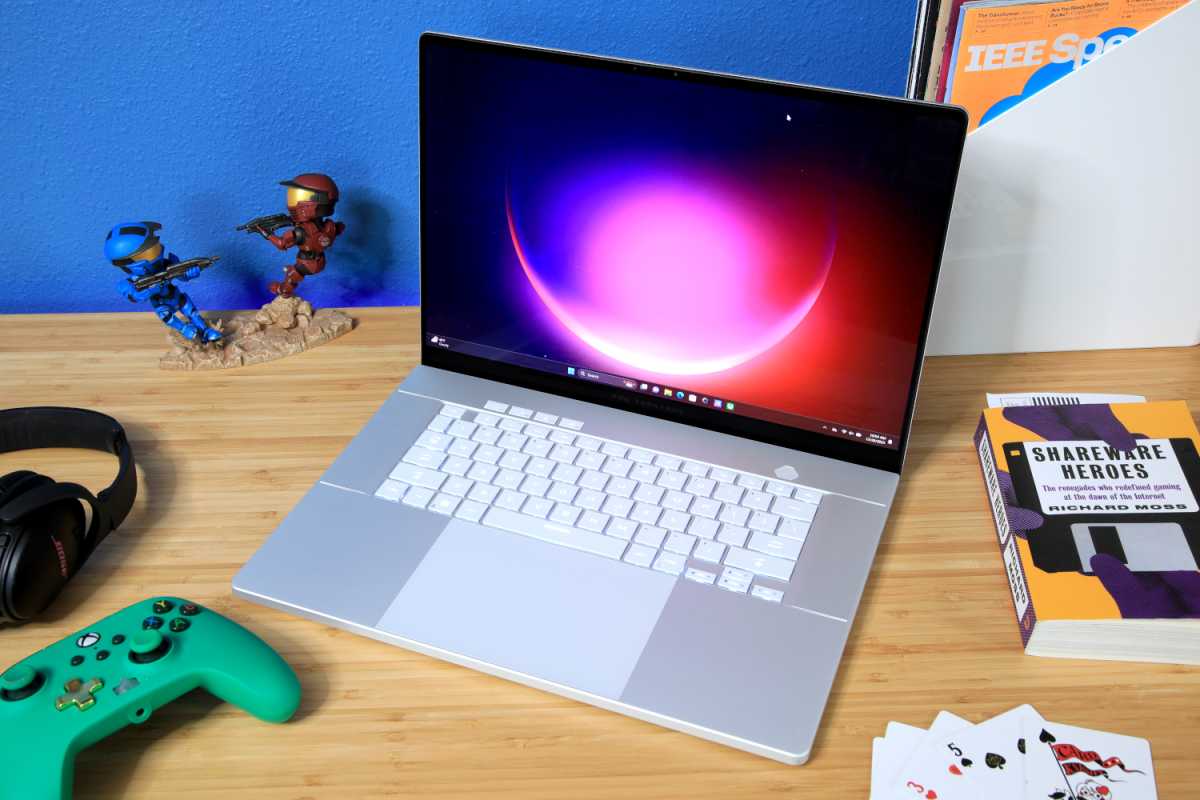
IDG / Matthew Smith
They are, in fact, the very first OLED laptops to support Nvidia G-Sync. Those not recently in the market for a gaming laptop might be surprised to learn that OLED displays with G-Sync (or AMD FreeSync) weren’t a thing, but it’s true.
Most OLED laptops on the market today use a panel from Samsung. According to Asus, each pixel on the panel is not continuously lit but instead turns on and off many times each second (this, by the way, isn’t true of the OLED panels used by monitors, which is why most OLED monitors support Adaptive Sync). These rapid fluctuations aren’t normally perceptible, but could cause fluctuations in brightness when paired with G-Sync. Asus says it worked with Nvidia and Samsung Display to increase the OLED panel’s pixel emission rate to 960Hz, which is high enough to eliminate the problem.
Technical details aside, bringing G-Sync to the Zephyrus G14 and G16 eliminates a huge pain point for gamers. Everyone looking to buy a gaming laptop last year had to choose between an IPS panel with Adaptive Sync or an OLED panel without it. Asus’ new G14 and G16 deliver the best of both worlds.
The ROG Zephyrus G14 and G16 both look wonderfully smooth in motion and present a clean, crisp image with minimal blur. That’s doubly true of the G16, which has a 240Hz panel. Its motion clarity is, if anything, a tad better than 27-inch 240Hz OLED monitors which have crossed my desk. And Asus quotes a pixel response time of 0.02 milliseconds, a blistering .01 milliseconds quicker than most OLED monitors.
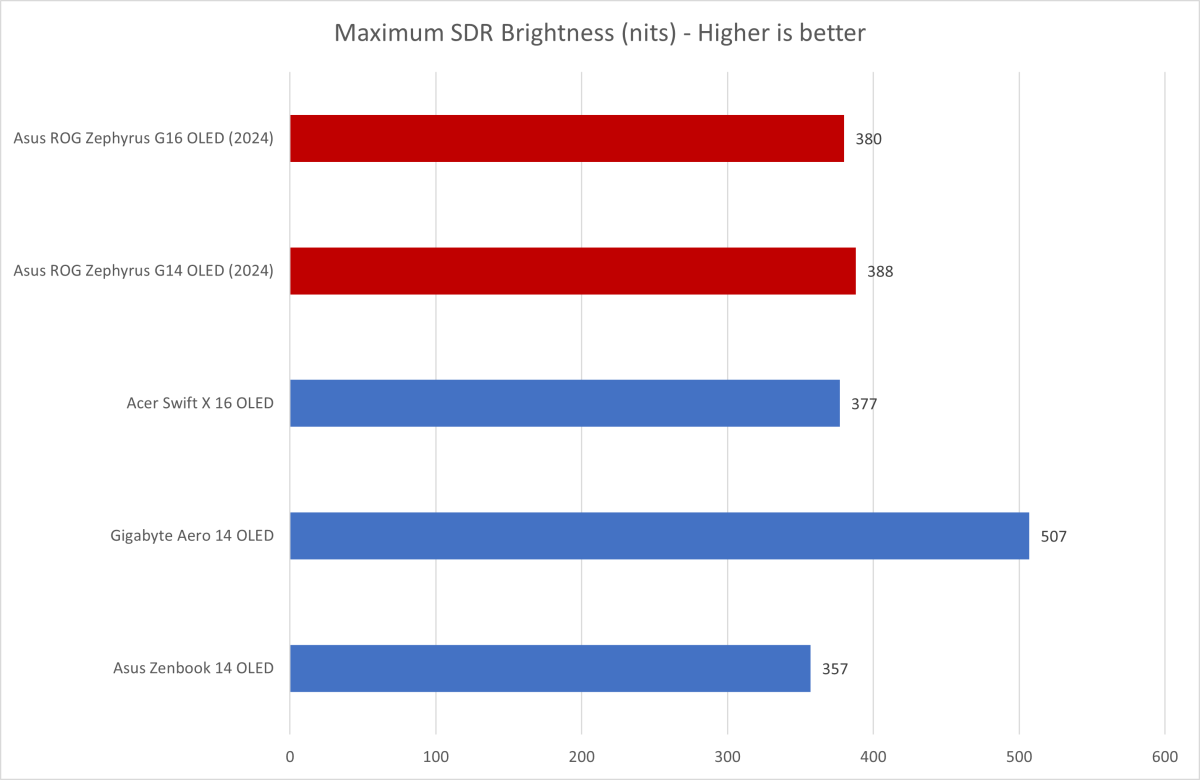
IDG / Matthew Smith
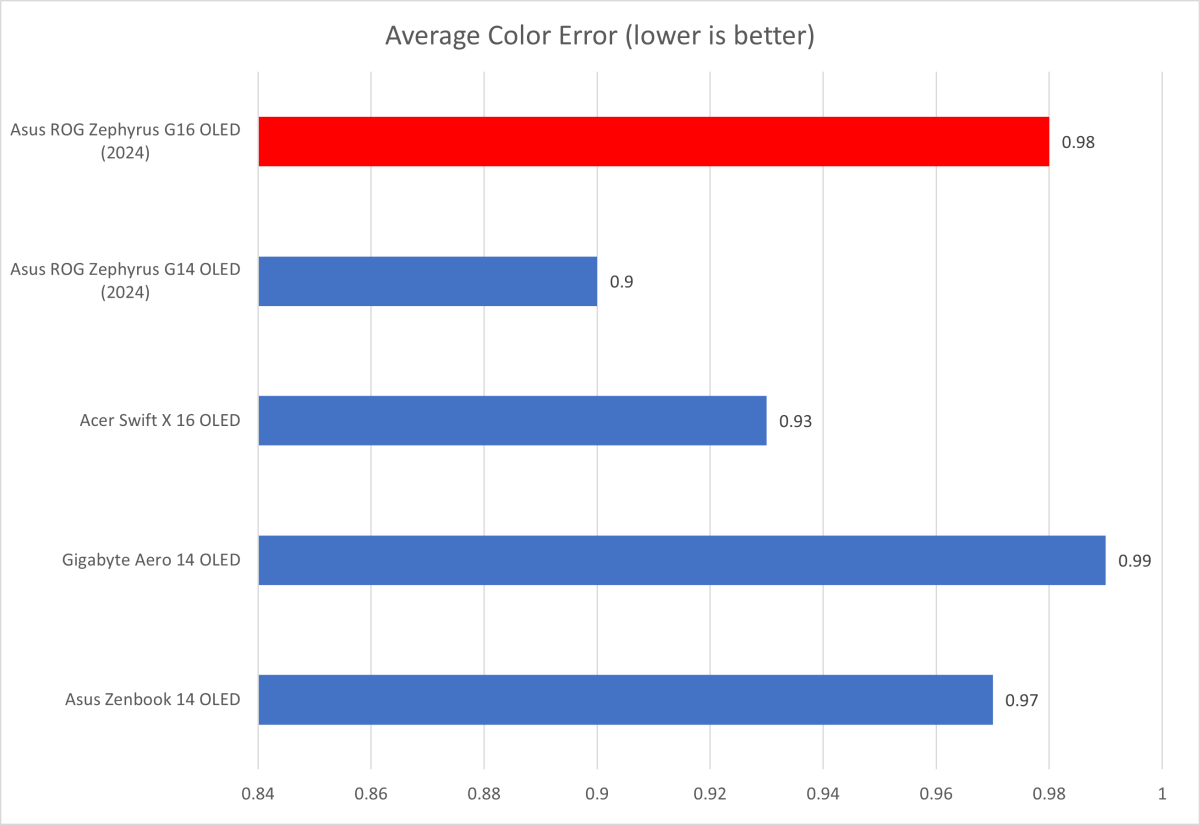
IDG / Matthew Smith
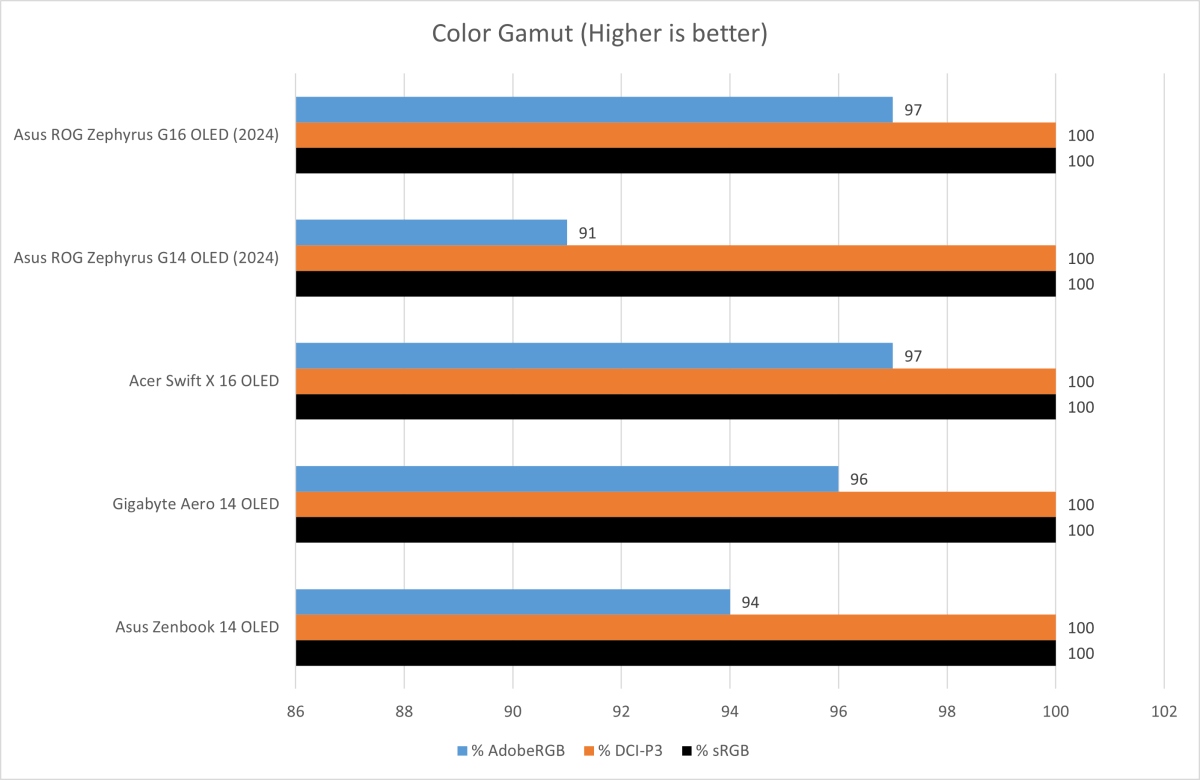
IDG / Matthew Smith

IDG / Matthew Smith
The OLED displays also deliver the usual perks. They have an essentially infinite contrast ratio with a minimum luminance of zero nits, no matter the panel’s brightness level. Color performance is spectacular, too, with a color gamut that spans 100 percent of sRGB, 100 percent of DCI-P3, and at least 91 percent of AdobeRGB (this is one test where the G14 and G16 differed: the G14 hit 91 percent of AdobeRGB, while the G16 scored an even better 97 percent). Color accuracy was excellent, too.
What about brightness? Well, it’s not Mini-LED, but it’s still rather good. Both the G14 and G16 hit a maximum SDR brightness around 380 nits and a maximum HDR brightness of 600 nits. The HDR brightness is the highest I’ve yet recorded from any OLED laptop. I also noticed the brightness barely dipped when the entire display was lit, which was a common downside with older OLED displays. The brightness was pegged at 588 nits when displaying a full, bright, white HDR image.
Put simply: the G14 and G16 have the best OLED displays of any laptop I’ve ever tested. It’s a small win and, HDR brightness aside, I couldn’t notice the difference when comparing these new laptops with a pair of older OLED laptops I had on hand. Still, a win is a win.
Conclusion
The Asus ROG Strix Scar 18 with Mini-LED display, alongside the G14 and G16 with OLED displays, offer a glimpse at the cutting edge of laptop display technology. Asus has carefully observed the pros and cons of each and reached a firm conclusion. “Why not both?”
It’s a valid strategy, and one I expect all laptop manufacturers will adopt. Mini-LED is the last word in HDR brightness and lacks the burn-in worries that cause some shoppers to break out in a cold sweat. OLED isn’t as bright, and the potential for burn-in may give some shoppers pause, but the contrast delivered by its deep, abyssal black levels and precise per-pixel lighting are unmatched by even the most capable Mini-LED displays.
And Asus is doing its part at CES 2024 to push both forward. The Asus ROG Strix Scar 18 delivers the most dimming zones of any Windows laptop so far; the ROG Zephyrus G14 and G16 finally bring G-Sync to OLED laptops. Both are major, tangible upgrades that address the biggest downsides in the prior incarnation of each display technology.
That’s progress — and I love to see it.




